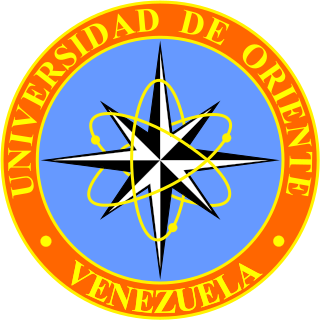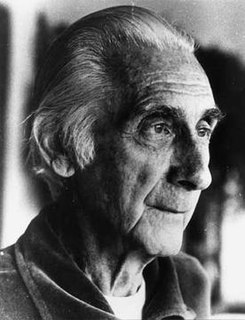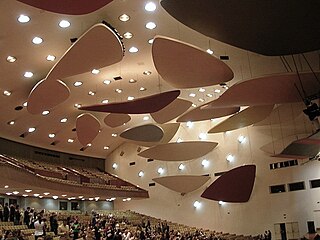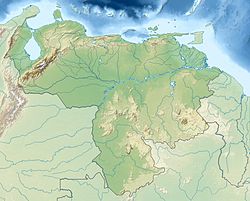
Caracas, officially Santiago de León de Caracas, abbreviated as CCS, is the capital and largest city of Venezuela, and the center of the Metropolitan Region of Caracas. Caracas is located along the Guaire River in the northern part of the country, within the Caracas Valley of the Venezuelan coastal mountain range. The valley is close to the Caribbean Sea, separated from the coast by a steep 2,200-meter-high (7,200 ft) mountain range, Cerro El Ávila; to the south there are more hills and mountains. The Metropolitan Region of Caracas has an estimated population of almost 5 million inhabitants.

The Central University of Venezuela is a public university of Venezuela located in Caracas. It is widely held to be the highest ranking institution in the country, and it also ranks 18th in Latin America. Founded in 1721, it is the oldest university in Venezuela and one of the oldest in the Western Hemisphere.

The University of Oriente Venezuela is one of the most important universities of Venezuela, located in Eastern Venezuela.

The University City of Caracas, also known by the acronym CUC, is the main campus of the Central University of Venezuela (UCV), located in central Caracas, the capital of Venezuela. It was designed by the Venezuelan architect Carlos Raúl Villanueva and was declared a World Heritage Site by UNESCO in 2000. The Ciudad Universitaria de Caracas is considered a "masterpiece" of architecture and urban planning, and greatly influenced Venezuelan architecture.

Pedro León Zapata was a prominent Venezuelan artist, humorist and cartoonist.

Juan David García Bacca, was a Spanish–Venezuelan philosopher and university professor.

Adriano González León was a Venezuelan writer who is known in his country for the novel País Portátil (1968), widely regarded as the premier Venezuelan novel of the latter half of the 20th century, and for his many years of hosting a television program dedicated to promoting literary appreciation among the general public.

The Sabana Grande district is divided into several middle class neighborhoods located in the Parroquia El Recreo of the Libertador Municipality, in the geographical center of the Metropolitan District of Caracas and owes its name to the old town of Sabana Grande.

Rafaela Requesens is a former president of the Federation of the Students Center of the Central University of Venezuela (FCU–UCV), an organiser of student protests in Venezuela, and an activist in the country. She was a prominent figure of the 2017 Venezuelan protests, along with her brother, Juan Requesens, and has since become a prominent democracy activist.

The Aula Magna is an auditorium at the Central University of Venezuela. It is located within the University City of Caracas, next to the University's main library building. The hall was designed by the Venezuelan architect Carlos Raúl Villanueva in the 1940s and built by the Danish company Christiani & Nielsen from 1952–53. It was declared a UNESCO World Heritage Site in November 2000 for being artistically and architecturally significant. The most notable feature of the hall is its acoustic 'clouds', which serve both aesthetic and practical functions. They are an element of the hall's design which contributed to the science of interior space acoustics, though the building exterior is also architecturally significant.

Tierra de nadie is the unofficial name of a public green space officially called Plaza Jorge Rodríguez in the University City of Caracas, the campus of the Central University of Venezuela.

Ciudad Universitaria is a Caracas Metro station on Line 3. It was opened on 18 December 1994 as part of the inaugural section of Line 3 from Plaza Venezuela to El Valle. The station is between Plaza Venezuela and Los Símbolos.

Conductores de Venezuela is a giant ceramic mural on a wall outside the Covered Gymnasium at the Central University of Venezuela, facing out to the Francisco Fajardo freeway. It was designed by cartoonist Pedro León Zapata and installed over a period of years in the late 1990s; it depicts cartoon Venezuelan people driving, with several vehicles having important Venezuelans from history behind the wheel.

Rectory Plaza, originally The Empty Plaza, is the name of a space located within the University City of Caracas, the campus of the Central University of Venezuela, in the San Pedro parish in the west of the city of Caracas.

The Biblioteca Central de la UCV, or Central Library is the main library in the University City of Caracas, and the most important one of the Central University of Venezuela. It is easily accessible from anywhere in the city as it is near the Caracas Metro line 3 station Ciudad Universitaria.

The UCV Clock Tower, also known by its Spanish name Torre del Reloj de la UCV, or Reloj de la UCV, is a monument made of prestressed concrete. It is by the Rectory Plaza of the Central University of Venezuela in the University City of Caracas, and was built between 1953 and 1954.

Floating Clouds is a work of art by American sculptor Alexander Calder, located in the Aula Magna of the University City of Caracas in Venezuela. The 1953 work comprises many 'cloud' panels that are renowned both artistically and acoustically. The piece is seen as "one of Calder's most truly monumental works" and the prime example of the urban-artistic theory of campus architect Carlos Raúl Villanueva.

Francisco Narváez was commissioned to create pieces for the University City of Caracas campus in 1949, initially working between 1950 and 1953, with other pieces added later. The artworks include stone and metal statues, busts, reliefs, and various material of murals. Three of the statues are made of Cumarebo stone: El Atleta, a large statue in the sports complex, and La educación and La ciencia in the medical complex. The Cumarebo stone is a favourite material of Narváez. Two sculptures of the esteemed doctor José Gregorio Hernández and President José María Vargas grace the campus grounds.

Venezuelan artist Mateo Manaure was commissioned to create pieces for the University City of Caracas.

























